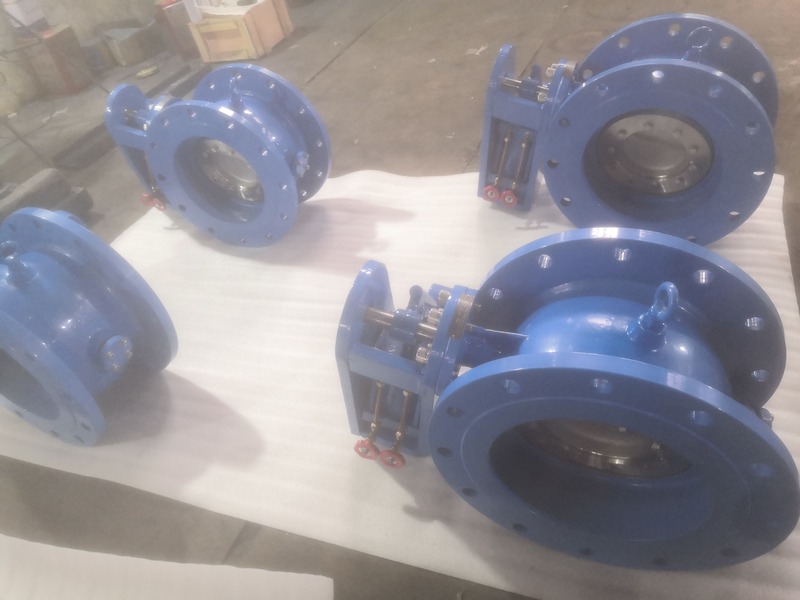Leakage of valve body and bonnet:
Reason:
1. The casting quality of iron castings is not high, and there are defects such as blisters, loose tissues, slag inclusions on the valve body and bonnet body
2. Freeze cracking;
3. Poor welding, there are defects such as slag inclusion, non-welding, stress cracks, etc.;
4. The cast iron valve is damaged after being hit by a heavy object.
Maintenance method:
1. Improve the casting quality, and carry out the strength test in strict accordance with the regulations before installation;
2. For valves whose temperature is below 0° and 0°, they should be kept warm or mixed with heat, and the valves that are out of service should be drained of stagnant water.
3. The welding seam of the valve body and bonnet composed of welding shall be carried out in accordance with the relevant welding operation regulations, and the flaw detection and strength test shall be carried out after welding;
4. It is forbidden to push and put heavy objects on the valve, and it is not allowed to hit the cast iron and non-metal valves with a hand hammer. The installation of large-diameter valves should have brackets.
Leakage at the packing (external leakage of the valve, the proportion of the packing is the largest)
Reason:
1. Wrong selection of packing, not resistant to medium corrosion, not resistant to valve high pressure or vacuum, high temperature or low temperature use;
2. The packing is not installed correctly, there are defects such as replacing the big with the small, and the screw-wound joint is not tightened and loosened;
3. The filler has exceeded the service life, has aged and lost its elasticity
4. The valve stem is not high in precision and has defects such as bending, corrosion, and wear;
5. The number of packing circles is insufficient, and the gland is not tightly pressed
6. The gland, bolts and other parts are damaged, making the gland unable to be compressed;
7. Improper operation, excessive force;
8. The gland is slanted, and the gap between the gland and the valve stem is too small or too large, resulting in valve stem wear and packing damage;
Maintenance method:
1. The material and type of filler should be selected according to the working conditions.
2. Install the packing correctly according to the relevant regulations, the packing should be securely compressed one by one, and the joint should be 30° or 45°.
3. The packing that has been used for too long, aging and damaged should be replaced in time;
4. If the valve stem is bent, it should be straightened and repaired after it is worn out. If it is seriously damaged, it should be replaced in time;
5. The packing should be installed according to the specified number of turns, the gland should be tightened symmetrically and evenly, and the braces should have a pre-tightening gap of more than 5mm;
6. Damaged glands, bolts and other parts should be repaired or replaced in time;
7. The operating procedures should be followed, and except percussion handwheel, others should be operated at a constant speed and normal force;
8. The gland bolts should be tightened evenly and symmetrically. If the gap between the gland and the valve stem is too small, the gap should be increased appropriately; the gap between the gland and the valve stem is too large and should be replaced.
The leakage of the sealing surface
reason:
1. The sealing surface is unevenly ground and cannot form a tight line;
2. The top center of the connection between the valve stem and the closing part is suspended, incorrect or worn;
3. The valve stem is bent or incorrectly assembled, which makes the closing part skewed or misaligned;
4. Improper selection of the quality of the sealing surface material or failure to select the valve according to the working conditions
Maintenance method:
1. Correctly select the material and type of the gasket according to the working conditions;
2. Carefully adjust and operate smoothly;
3. The bolts should be tightened evenly and symmetrically, and a torque wrench should be used when necessary. The pre-tightening force should meet the requirements and should not be too large or small. There should be a certain pre-tightening gap between the flange and the threaded connection;
4. The gasket assembly should be aligned at the center, and the force should be even. The gasket is not allowed to overlap or use double gaskets;
5. The static sealing surface is corroded, damaged, and the processing quality is not high. Repair, grinding, and color inspection should be carried out to make the static sealing surface meet the relevant requirements;
6. Pay attention to cleaning when installing the gasket. The sealing surface should be cleaned with kerosene and the gasket should not fall to the ground.
Leakage at the joint of the sealing ring
reason:
1. The sealing ring is not tightly rolled
2. The sealing ring is welded to the body, and the surfacing quality is poor;
3. The sealing ring connection thread, screw and pressing ring are loose;
4. The sealing ring is connected and corroded.
Maintenance method:
1. The leakage of the seal rolling should be filled with adhesive and then rolled and fixed;
2. The sealing ring should be repaired according to the welding specification. The original surfacing and processing should be removed when the surfacing part cannot be repaired;
3. Remove the screws and pressure ring to clean, replace the damaged parts, grind the sealing surface of the seal and the connecting seat, and reassemble. For parts with large corrosion damage, welding, bonding and other methods can be used to repair;
4. The connecting surface of the sealing ring is corroded, it can be repaired by grinding, bonding and other methods. If it cannot be repaired, the sealing ring should be replaced.
The closure part falls off and causes leakage:
Reason:
1. Poor operation makes the closing part stuck or exceeds the top dead center, and the connection is damaged and broken;
2. The closing piece is not firmly connected, loosened and falls off;
3. The wrong connection material is selected, which can not withstand the corrosion of the medium and mechanical abrasion.
Maintenance method:
1. Operate correctly, do not use excessive force to close the valve, and open the valve not to exceed the top dead center. After the valve is fully opened, the handwheel should be reversed a little;
2. The connection between the closing piece and the valve stem should be firm, and there should be a stop piece at the threaded connection;
3. The fastener used to connect the closing part and the valve stem should withstand the corrosion of the medium, and have a certain degree of mechanical strength and wear resistance.

